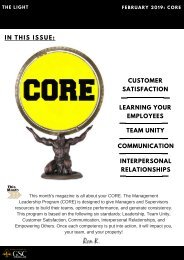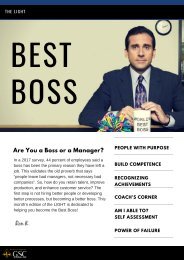Coaching & Leadership
July 2018
July 2018
Create successful ePaper yourself
Turn your PDF publications into a flip-book with our unique Google optimized e-Paper software.
T H E L I G H T<br />
J U L Y 2 0 1 8 : C O A C H I N G<br />
A N D L E A D E R S H I P<br />
COACHING AND LEADERSHIP<br />
The GSC management magazine is called the LIGHT. Each edition will assist you in<br />
developing the skills to Lead—Inspire—Grow—Help—Train your team.<br />
This month’s edition of the LIGHT is about <strong>Coaching</strong> and <strong>Leadership</strong>. The success<br />
of your team is directly linked to your ability to coach and lead. Coaches develop and<br />
Leaders inspire. How developed and inspired is your team to achieve the goals of<br />
GSC? Regardless of your answer, this issue will help you.<br />
Be The LIGHT!<br />
I N T H I S I S S U E :<br />
KNOW YOUR<br />
COACHING STYLE<br />
|<br />
PROGRESSIVE<br />
|<br />
LAWS OF<br />
|<br />
DIALOGUE<br />
LEADERSHIP<br />
WIN TOGETHER
Know Your <strong>Coaching</strong> Style<br />
As a manager, one of your daily tasks is to coach your team. <strong>Coaching</strong> is comprised of four parts or styles,<br />
Direct (Take Charge), Spirited (Inspire), Considerate (Facilitate) and Systematic (Planning). Below is an<br />
overview of the 4 coaching styles. Read each style, and then select the style(s) that best describes you.<br />
Your goal is to learn how to transition to the style best suited for the individual and the situation. In today’s<br />
business world a coach who is not good at transitioning between all four styles runs the risk of having<br />
under-performing teams and not achieving business goals.<br />
Source: HDRQ
Progressive Dialogue<br />
Coaches instruct, train, develop, assist, and support ongoing performance. They use an effective feedback<br />
process to direct and redirect work efforts and behaviors. When coaching your employees, you help them gain<br />
self-awareness and insight into their demonstrated behavior. Successful coaching helps the employee<br />
understand what behaviors they should continue and which do not support their development. Below are some<br />
tips for progressive dialogues.<br />
<strong>Coaching</strong> tips for reinforcing successful behavior:<br />
• Focus on one successful behavior; recount its outcomes and impacts in detail to the employee.<br />
• Point out the elements that contributed to the result being such a success.<br />
• Brainstorm with the employee ways to replicate that behavior in other circumstances.<br />
• Describe the benefits of this behavior and your confidence in the employee’s ability to continue demonstrating.<br />
<strong>Coaching</strong> tips for addressing poor performance:<br />
• Describe one thing the employee could do differently to achieve greater success.<br />
• Listen carefully and be open to the employee’s perspective without judgement.<br />
• Involve the employee in identifying how they can master and apply the new desired behavior.<br />
• Watch for and acknowledge demonstration of the new desired behavior.<br />
• Set dates for a follow up discussion.<br />
<strong>Coaching</strong> tips for following up on poor performance:<br />
• Review the initial discussion on poor performance and<br />
commend their progress in demonstrating improved<br />
behaviors and performance.<br />
• Check in to ensure they have all the support and resources<br />
they believe necessary to help them change their behavior;<br />
allocate as required.<br />
• Set dates for improvement milestones.<br />
• Continuously communicate your confidence in the<br />
employee and your support of their development.
Laws of <strong>Leadership</strong><br />
John Maxwell is an author, thoughtful leader, and strategist on the topic of leadership. In his book, “21 Irrefutable<br />
Laws of <strong>Leadership</strong>,” he shares insight that leaders need to produce winning teams. Below are five of John’s laws<br />
that will help you lead your team to victory.<br />
1) The Law of the Lid: <strong>Leadership</strong> ability<br />
determines a person’s level of<br />
effectiveness. The ability to lead is the “lid”<br />
that determines a person’s effectiveness.<br />
The lower an individual’s ability to lead, the<br />
lower the lid on his potential. The better a<br />
person is at leading, the higher the lid on<br />
his potential for achievement.<br />
2) The Law of Influence: If you don’t have<br />
influence, you will never be able to lead<br />
others. True leadership cannot be assigned<br />
and titles are often meaningless in this<br />
sense. <strong>Leadership</strong> must be earned. The<br />
only thing a title can buy is little time- either<br />
to increase your level of influence with<br />
others or to undermine it.<br />
Trust + Unity =<br />
winning<br />
Myths: The management myth holds<br />
that leading and managing is the<br />
same thing. However, leadership is<br />
about influencing people, while<br />
management is about maintaining<br />
systems and processes.<br />
3) The Law of Process: <strong>Leadership</strong> develops daily, not in a day. Becoming a leader is like investing in the<br />
stock market. If you try to make a fortune in a day, you won’t succeed. What matters most is what you do day<br />
to day over the long haul. If you continually invest in your leadership development, letting your assets<br />
compound, the inevitable result is growth over time.<br />
4) The Law of Addition: Leaders add value by serving others. <strong>Leadership</strong> is about advancing others, not about<br />
advancing yourself. Leaders who add value to others do intentionally. The critical question is this: Are you<br />
making things better for the people who follow you?<br />
5) The Law of Solid Ground: Trust is the foundation of leadership. Trust is the most important thing a leader<br />
must engender. A leader builds trust by consistently exemplifying competence, connection and character.<br />
People will tolerate honest mistakes. People will also give leaders a grace period for connection with others.<br />
However, they won’t forgive lapses in character.
Coach's Corner:<br />
Further Reading is available through the<br />
GSC Training Department!<br />
Request your copy of Joel Kurtzman's "Common Purpose: How Great Leaders Get<br />
Organizations to Achieve the Extraordinary" to learn even more ways to develop<br />
strengths within yourself and on your teams.
Win Together<br />
Leaders are Part of the Group<br />
An effective leader needs to create a<br />
culture of leadership by making<br />
leadership everyone’s responsibility,<br />
and by helping people build networks of<br />
support within the organization.<br />
Sometimes a leader stands in front,<br />
sometimes to the side, and sometimes<br />
even behind the people he or she is<br />
trying to help reach a goal.<br />
Everyone on your team shares responsibility for reaching a goal. Individuals take their cues from the way other<br />
people on the team behave. They look to the right and left, but they also look at the leader for ways to model<br />
their behavior. Consciously or unconsciously, people copy behaviors that are rewarded and that they perceive<br />
are necessary to get ahead. As a result, leaders responsible for their organization, not only by the actions they<br />
take, but also because of the behaviors they exhibit.<br />
Creating a Culture of <strong>Leadership</strong><br />
You cannot have a common purpose unless<br />
everyone is on-board with the same goals. No<br />
one operates on a team alone. Preventing people<br />
from breaking down into a group of rivals<br />
depends upon helping people connect to one<br />
another. When people know who everyone is,<br />
what everyone does, and where to go for help,<br />
then they know how to enlist others to help them<br />
succeed. You simply cannot lead if you do not<br />
know the people you are leading.<br />
How Leaders Stay Positive and Determined<br />
Individuals on a team can cope and succeed in tough times if they understand the reality of their situation and<br />
if they know they will be protected.The power of a group that is in tune with each other can be phenomenal.<br />
When a group of people are positive, in harmony, and are doing and accomplishing goals, they set a tone for<br />
others to follow. Overall the work improves, the group gains admiration, and people who pass through these<br />
groups end up with a career boost. Resonant leaders set a positive emotional tone and a sense of hope that is<br />
contagious. They set up an environment where people care about each other, and there is a high degree of<br />
authenticity. Positive emotions are triggered by praise and people feel more open. They become more<br />
receptive to advice, open to new ideas, and taking risks.
Follow us on Instagram @GSCTrainingDept<br />
Do you have a request you'd like to see<br />
featured? Reach out to us at<br />
dmeeler@gscapts.com<br />
In your experience, What is the most influential tool<br />
you use to improve Employee Performance?<br />
Share your thoughts with us!












